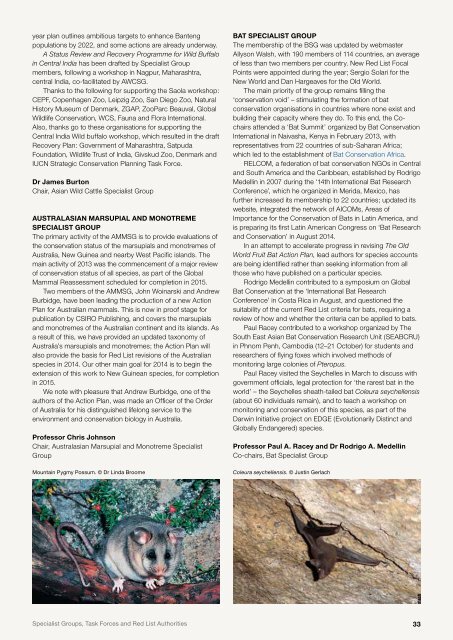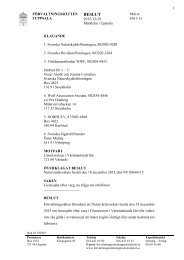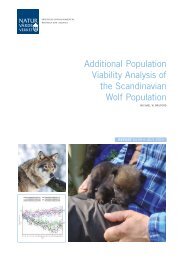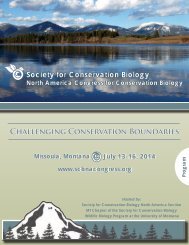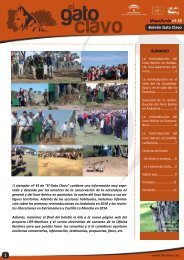1oC3Dbk
1oC3Dbk
1oC3Dbk
You also want an ePaper? Increase the reach of your titles
YUMPU automatically turns print PDFs into web optimized ePapers that Google loves.
year plan outlines ambitious targets to enhance Banteng<br />
populations by 2022, and some actions are already underway.<br />
A Status Review and Recovery Programme for Wild Buffalo<br />
in Central India has been drafted by Specialist Group<br />
members, following a workshop in Nagpur, Maharashtra,<br />
central India, co-facilitated by AWCSG.<br />
Thanks to the following for supporting the Saola workshop:<br />
CEPF, Copenhagen Zoo, Leipzig Zoo, San Diego Zoo, Natural<br />
History Museum of Denmark, ZGAP, ZooParc Beauval, Global<br />
Wildlife Conservation, WCS, Fauna and Flora International.<br />
Also, thanks go to these organisations for supporting the<br />
Central India Wild buffalo workshop, which resulted in the draft<br />
Recovery Plan: Government of Maharashtra, Satpuda<br />
Foundation, Wildlife Trust of India, Givskud Zoo, Denmark and<br />
IUCN Strategic Conservation Planning Task Force.<br />
Dr James Burton<br />
Chair, Asian Wild Cattle Specialist Group<br />
Australasian Marsupial and Monotreme<br />
Specialist Group<br />
The primary activity of the AMMSG is to provide evaluations of<br />
the conservation status of the marsupials and monotremes of<br />
Australia, New Guinea and nearby West Pacific islands. The<br />
main activity of 2013 was the commencement of a major review<br />
of conservation status of all species, as part of the Global<br />
Mammal Reassessment scheduled for completion in 2015.<br />
Two members of the AMMSG, John Woinarski and Andrew<br />
Burbidge, have been leading the production of a new Action<br />
Plan for Australian mammals. This is now in proof stage for<br />
publication by CSIRO Publishing, and covers the marsupials<br />
and monotremes of the Australian continent and its islands. As<br />
a result of this, we have provided an updated taxonomy of<br />
Australia’s marsupials and monotremes; the Action Plan will<br />
also provide the basis for Red List revisions of the Australian<br />
species in 2014. Our other main goal for 2014 is to begin the<br />
extension of this work to New Guinean species, for completion<br />
in 2015.<br />
We note with pleasure that Andrew Burbidge, one of the<br />
authors of the Action Plan, was made an Officer of the Order<br />
of Australia for his distinguished lifelong service to the<br />
environment and conservation biology in Australia.<br />
Professor Chris Johnson<br />
Chair, Australasian Marsupial and Monotreme Specialist<br />
Group<br />
Mountain Pygmy Possum. © Dr Linda Broome<br />
Bat Specialist Group<br />
The membership of the BSG was updated by webmaster<br />
Allyson Walsh, with 190 members of 114 countries, an average<br />
of less than two members per country. New Red List Focal<br />
Points were appointed during the year; Sergio Solari for the<br />
New World and Dan Hargeaves for the Old World.<br />
The main priority of the group remains filling the<br />
‘conservation void’ – stimulating the formation of bat<br />
conservation organisations in countries where none exist and<br />
building their capacity where they do. To this end, the Cochairs<br />
attended a ‘Bat Summit’ organized by Bat Conservation<br />
International in Naivasha, Kenya in February 2013, with<br />
representatives from 22 countries of sub-Saharan Africa;<br />
which led to the establishment of Bat Conservation Africa.<br />
RELCOM, a federation of bat conservation NGOs in Central<br />
and South America and the Caribbean, established by Rodrigo<br />
Medellin in 2007 during the ‘14th International Bat Research<br />
Conference’, which he organized in Merida, Mexico, has<br />
further increased its membership to 22 countries; updated its<br />
website, integrated the network of AICOMs, Areas of<br />
Importance for the Conservation of Bats in Latin America, and<br />
is preparing its first Latin American Congress on ‘Bat Research<br />
and Conservation’ in August 2014.<br />
In an attempt to accelerate progress in revising The Old<br />
World Fruit Bat Action Plan, lead authors for species accounts<br />
are being identified rather than seeking information from all<br />
those who have published on a particular species.<br />
Rodrigo Medellin contributed to a symposium on Global<br />
Bat Conservation at the ‘International Bat Research<br />
Conference’ in Costa Rica in August, and questioned the<br />
suitability of the current Red List criteria for bats, requiring a<br />
review of how and whether the criteria can be applied to bats.<br />
Paul Racey contributed to a workshop organized by The<br />
South East Asian Bat Conservation Research Unit (SEABCRU)<br />
in Phnom Penh, Cambodia (12–21 October) for students and<br />
researchers of flying foxes which involved methods of<br />
monitoring large colonies of Pteropus.<br />
Paul Racey visited the Seychelles in March to discuss with<br />
government officials, legal protection for ‘the rarest bat in the<br />
world’ – the Seychelles sheath-tailed bat Coleura seychellensis<br />
(about 60 individuals remain), and to teach a workshop on<br />
monitoring and conservation of this species, as part of the<br />
Darwin Initiative project on EDGE (Evolutionarily Distinct and<br />
Globally Endangered) species.<br />
Professor Paul A. Racey and Dr Rodrigo A. Medellin<br />
Co-chairs, Bat Specialist Group<br />
Coleura seychellensis. © Justin Gerlach<br />
Specialist Groups, Task Forces and Red List Authorities<br />
33


